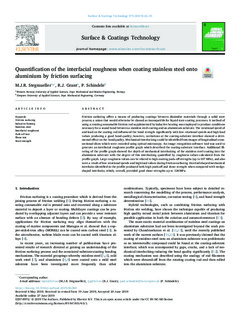| dc.contributor.author | Stegmüller, Michael J.R. | |
| dc.contributor.author | Grant, Richard John | |
| dc.contributor.author | Schindele, Paul | |
| dc.date.accessioned | 2019-09-25T13:49:15Z | |
| dc.date.available | 2019-09-25T13:49:15Z | |
| dc.date.created | 2019-08-01T15:31:11Z | |
| dc.date.issued | 2019 | |
| dc.identifier.citation | Stegmueller, M. J. R., Grant, R. J., & Schindele, P. (2019). Quantification of the interfacial roughness when coating stainless steel onto aluminium by friction surfacing. Surface and Coatings Technology, 375, 22-33. | nb_NO |
| dc.identifier.issn | 0257-8972 | |
| dc.identifier.uri | http://hdl.handle.net/11250/2618791 | |
| dc.description.abstract | Friction surfacing offers a means of producing coatings between dissimilar materials through a solid state process; a union that would otherwise be classed as incompatible for liquid state coating processes. A method of using a rotating consumable friction rod supplemented by inductive heating was employed to produce conditions necessary for a sound bond between a stainless steel coating and an aluminium substrate. The rotational speed of and load on the coating rod influenced the bond strength significantly with low rotational speeds and high load values producing a good bond quality; however, cavitations at the coating-substrate interface showed a detrimental effect on the bond quality. Mechanical interlocking could be identified from images of longitudinal cross-sectional slices which were recorded using optical microscopy. An image recognition software tool was used to generate an interfacial roughness profile graph which described the coating-substrate interface. Additional filtering of the profile graph showed the depth of mechanical interlocking of the stainless steel coating into the aluminium substrate with the degree of this interlocking quantified by roughness values calculated from the profile graph. Large roughness values can be related to high coating push-off strengths (up to 107 MPa), and also were a result of low rotational speeds and high load values during friction surfacing. Dovetail shaped mechanical interlocks identified in the profile produced both high push-off and shear strength when compared with wedge-shaped interlocks; which, overall, provided good shear strengths up to 126 MPa. | nb_NO |
| dc.language.iso | eng | nb_NO |
| dc.publisher | Elsevier | nb_NO |
| dc.rights | Attribution-NonCommercial-NoDerivatives 4.0 Internasjonal | * |
| dc.rights.uri | http://creativecommons.org/licenses/by-nc-nd/4.0/deed.no | * |
| dc.subject | friction surfacing | nb_NO |
| dc.subject | inductive heating | nb_NO |
| dc.subject | stainless steel | nb_NO |
| dc.subject | interfacial roughness | nb_NO |
| dc.subject | push-off test | nb_NO |
| dc.subject | shear test | nb_NO |
| dc.title | Quantification of the interfacial roughness when coating stainless steel onto aluminium by friction surfacing | nb_NO |
| dc.type | Journal article | nb_NO |
| dc.type | Peer reviewed | nb_NO |
| dc.description.version | publishedVersion | nb_NO |
| dc.rights.holder | © 2019 The Authors. | nb_NO |
| dc.source.pagenumber | 22-33 | nb_NO |
| dc.source.volume | 375 | nb_NO |
| dc.source.journal | Surface & Coatings Technology | nb_NO |
| dc.identifier.doi | 10.1016/j.surfcoat.2019.06.060 | |
| dc.identifier.cristin | 1713705 | |
| cristin.unitcode | 203,12,6,0 | |
| cristin.unitname | Institutt for maskin- og marinfag | |
| cristin.ispublished | true | |
| cristin.fulltext | original | |
| cristin.qualitycode | 1 | |

